I watched Grapes of Wrath directed by John Ford and based on the book written by John Steinbeck. It stars Henry Fonda in the leading role. The main reason that I decided to watch it is because I had read that John Steinbeck had based some of the book on field notes taken by the US Farm Security Administration(FSA) in 1938 during the Great Depression.
The photographs from the FSA survey of that time have long both intrigued and appalled me, especially the work done by Dorothea Lange and her iconic photo of the Migrant Mother.
Edward Steichen was the Director of the Department of Photography at the Museum of Modern Art in New York from after the Second World War until 1962. The last exhibition that he curated, in 1962, was The Bitter Years, a collection of approximately 200 photographs taken from the FSA survey showing the poverty and desperation of these rural people but somehow at the same time showing the resilience and ‘courage’ of these people. Edward Steichen was born in Luxembourg and it was his wish that the collection find a home in Luxembourg. The collection is now permanently displayed in a small village in Luxembourg, called Dudelange. The building that houses the exhibition is a converted water reservoir tower. It’s a strange place to house a photographic exhibition but it works well. I have visited this exhibition many times because it’s close to where I live and also because the photographs draw you back. Once you have seen these images, it is not possible to forget them.
I was curious to see what a film that is set in this era and based on some of the experiences of these people would be like.
The film was released in 1940. It was interesting to notice some of the differences between movie making in the 1940’s and today. Clearly there are some scenes where the background is a painting and the atmospheric conditions such as wind and dust storms are generated in a studio environment. Nonetheless, this does not detract from the storyline.
Possibly the most difficult aspect of watching this film is the exaggerated, over-acted performances of some of the supporting characters. I found it challenging to not be irritable with these characters and it brought home to me the infancy of the movie industry of the time.
I decided to concentrate my viewing on two aspects of the movie and how they aid the story:
- the setting, and
- the lighting
The mood and atmosphere of this movie is clearly somber; the Tom Joad and his family are starving, homeless and penniless. They have left their sharecrop farm in Oklahoma and travel to California to find work as migrant fruit-pickers. A large part of the movie is concerned with the journey to California. Most of the scenes are of vast open spaces, dusty roads, few cars and people, no water and blazing heat. Many of the VLS show the open, desolate country side. This countryside signifies the desolation of the Joad family and many others like them. They struggle through this harsh land only to find more hardship as they travel. It was a desperate time.
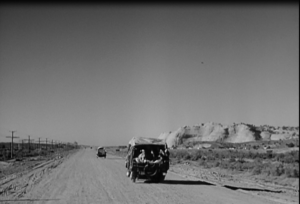
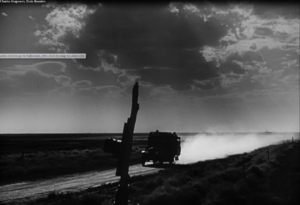
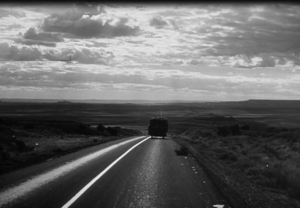
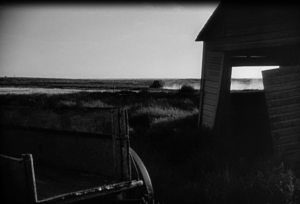
These images of the countryside are also a good portrayal of what it looked like during the Great Depression which has clearly been influenced by the FSA photos.
Another aspect of the mise-en-scene that is based on the FSA photos are the camps that the Joad family spent some time in. They are wooden shacks, poorly constructed, dirty, dusty with the remains of what people could not take with them anymore just lying around.
The people are shabbily dressed, sometimes grubby due lack of cleaning facilities, unshaven and gaunt-looking. Looking at the FSA photos you realise that the movie accurately reflects the state of affairs in these camps.
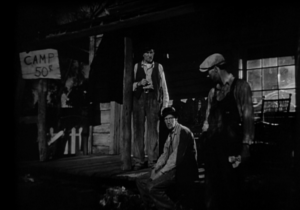
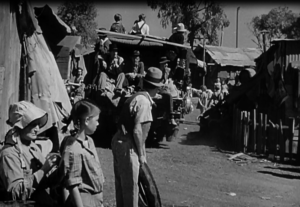
It took me some time to figure out what the director was doing with the lighting. At first I thought it was simply that scenes were dark to portray the desperate times, and to some extent this is true. But light is also used to indicate who the “good guys” are. In the scene where Tom Joad’s father goes into a roadside café to try to buy a dimes worth of bread and the owner gives him 15c worth of bread for the dime, the lighting is very bright on the owner and shop assistant and they are clearly seen. This is also true of one of the truckers who leaves his change behind so that the shop doesn’t go short of money. When the Joad’s arrive at the government run camp where conditions are significantly better, the manager of the camp is well lit and dressed in light coloured clothing as well.
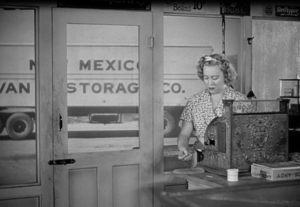
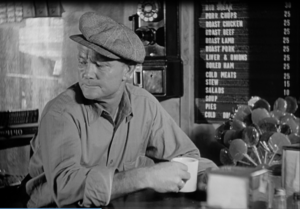
When the “bad guys” are introduced, they are frequently surrounded by darkness to emphasize their meanness, lack of compassion and sometimes outright cruelty and violence. In the scene where the local landowners are chasing the migrant workers away from their district, it is night time and they are lit only by the headlights of the car. They appear threatening and brutal.
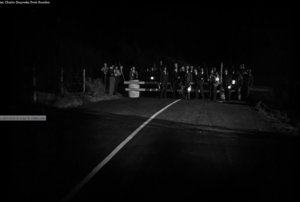
Another often used lighting technique that focused the audience attention on one a person, was by using a small single source of light. The light would usually come from a low angle and light the persons face from below in a way that made them look unnaturally gaunt. Yet again, this type of lighting could help to emphasize the poverty and discomfort of these people.
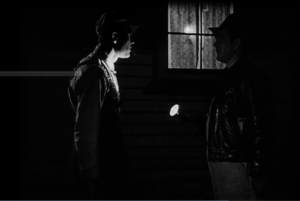
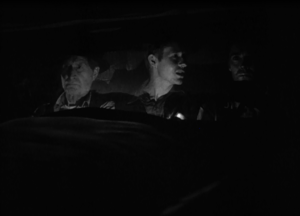
And finally a last observation about the movie. The use of non-diegetic sound was extremely minimal and so far as I can remember, was only used when the family was in the car and travelling the open countryside. For the other scenes, there were often long shots where there was no sound other than diegetic sound and very little dialogue. I’m not sure if this was simply how they made movies in the 1940’s but from my perspective it added to the sense of poverty and desolation.
Images taken from: The Grapes of Wrath [feature film,DVD] Dir John Ford. 20th Century Fox Film Corporation. Los Angeles, California. 1940. 129 min.
Edward Steichen – https://en.wikipedia.org/wiki/Edward_Steichen (accessed 20 April 2016)
The Bitter Years – http://www.steichencollections.lu/en/the-bitter-years (accessed 20 April 2016)

Interesting article on “Grapes of Wrath”, Ashley. In particular how you focused on how the lighting was brighter due to scenes of kindness and the vice versa.
recently I saw Terrence Malick’s classic “Days of Heaven” (1978) set in a similar scenario and although the film focuses on the ménage à trois of the film’s story line, the scenes are set in rural farmland within the seasonal workers and their desperate plight for employment. Although filled with striking colour and visuals, the hardship and sorrow still remain.
Peter
Thanks Peter, that could be an interesting on to watch. Amazing how a movie that is make in 1940 and dare I say, clearly studio acted, can still have such an effect.